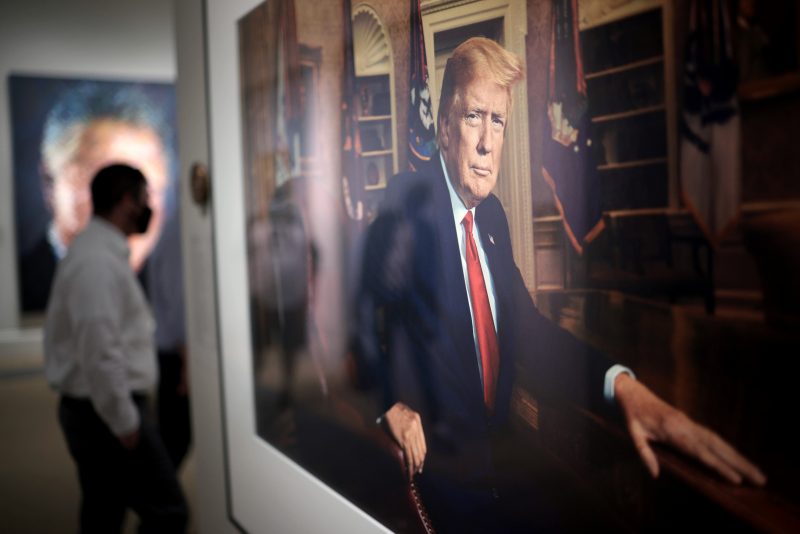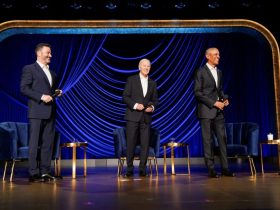Newly obtained emails indicate that several individual donors were willing to fund the official portraits of Trump and former first lady Melania Trump for the Smithsonian’s National Portrait Gallery, but that the Smithsonian ultimately agreed to instead accept a $650,000 contribution from Trump’s Save America PAC.
The donation marked the first time in recent memory that a political organization has financed a former president’s portrait for the museum, as they are typically paid for by individual donors solicited by the Smithsonian. News of the unusual gift, first reported in August by Business Insider, also sparked a public backlash against the museum and questions about the identity of a second donor who gave a separate $100,000 gift to help fund the portraits, according to emails obtained by the advocacy group Citizens for Responsibility and Ethics in Washington and reviewed Monday by The Washington Post.
Smithsonian spokeswoman Linda St. Thomas reiterated on Monday that the second donor is “a citizen and wished to remain anonymous.” She also noted that one of the portraits is complete and the other is “in process.”
However, museum rules dictate that portraits cannot be unveiled of a former president if that person runs for office again. Therefore, St. Thomas told The Post that the museum likely would not release the names of the two artists commissioned until after the 2024 presidential election. If Trump wins the presidential election in 2024, the portraits would not be displayed until after the end of his second term, per museum rules.
“We don’t release artist names until the unveiling, although that may change in this case because so much time will go by,” St. Thomas said. A 2019 photograph of Trump, taken by Pari Dukovic for Time magazine, is being temporarily displayed in the National Portrait Gallery’s “America’s Presidents” exhibit before the official portrait is revealed.
Negotiations between museum officials and those working with Trump over the portraits and their financing lasted for months, starting in early 2021, shortly after Trump left office, according to the emails.
Messages from National Portrait Gallery director Kim Sajet to Molly Michael, who was then Trump’s executive assistant after he was out of office, describe the process. Sajet notes that Trump would have final approval — or disapproval — of the painting before it goes on display.
“Of course, if Mr. Trump has thoughts of other artists we would welcome the suggestions,’ Sajet wrote in a March 18, 2021, email to Michael. “The goal is to come up with a painter whom both the museum and the sitter feel will create a good likeness for the America’s Presidents gallery in perpetuity.”
About two months later, Sajet also specified that the National Portrait Gallery raises private funds for all presidential portraits and asks for help contacting “friends and admirers of the Trumps who might support these commissions.”
She asked, however, that the potential donors not be related to Trump or be his businesses.
“To maintain a respectful distance between their personal lives and public legacies, we would prefer not to approach Trump family members or have any of the Trump businesses contribute,” Sajet wrote to Michael on May 28, 2021. It is unclear whether any guidelines regarding pro-Trump political action committees were set during the process, and representatives for the Smithsonian did not immediately reply to a follow-up email. A spokesperson for Trump did not immediately reply to an email for comment.
Michael told Sajet about a week later that she had identified several donors who “would like to give the full amount.”
“I’ll be sending over names and contact information in the coming days, just getting our ducks in a row and ascertaining POTUS’ final preferences,” Michael wrote.
Michael appeared to send over a list another week later, but those names were redacted in the publicly released emails viewed by The Post. Michael wrote that she had “a dozen more to come if needed.”
It is unclear what took place on the fundraising front after then and leading up to the decision to accept money from Trump’s PAC. Emails suggest that several conversations took place over the phone or in virtual meetings.
The two exchanged emails in September 2021 regarding a “first sitting” for the portraits. Then, on Feb. 17, 2022, Sajet sent Michael an email once again clarifying the museum’s collections policy.
″No living subject may be permitted to pay the costs of his or her own portrait,” Sajet wrote, quoting the policy. “The NPG may approach a sitter’s family members, friends, and acquaintances to cover the costs of the portrait commission as long as the NPG takes the lead in the negotiations and the solicited parties do not influence the choice of artist or price.”
On March 8, 2022, Sajet asked Michael if she could share any updates over the phone on those who had expressed an interest in supporting the museum’s work.
“We are starting to incur costs that will need to be paid, and we are keen to come to some close on the fundraising portion of our project,” Sajet wrote.
After a number of emails coordinating phone calls, Michael wrote to Sajet on March 25, 2022, saying that the “best contact to follow up on the discussion we had” was Susie Wiles — a Republican political consultant who would later be named a senior adviser on Trump’s 2024 reelection campaign.
In a May 11, 2022, letter on Smithsonian letterhead, museum officials wrote to Save America PAC treasurer Bradley Crate to acknowledge the political organization’s “recent generous pledge of $650,000” to support the commissions of the Trump portraits.
“To recognize this generous support, the Smithsonian will recognize Save America on the object labels that will be displayed alongside the portraits when they are on exhibition and alongside images of the portraits on the NPG website,” museum officials wrote.
The Save America PAC would also get to invite 10 guests to attend the unveiling ceremony and later organize a private viewing of the portraits for up to five guests, they added.
On July 20, 2022, Wiles emailed Usha Subramanian, director of advancement for the National Portrait Gallery, with a copy of the signed agreement.
The museum said last year that the commission fees for the two Trump portraits will be $750,000, to be covered by the Save America PAC donation and a second private gift of $100,000 from the undisclosed individual donor.
Though unusual, the donation is legal because Save America is a leadership PAC with few restrictions on the use of its money. Such political action committees, in addition to boosting like-minded candidates, can be used to pay advisers, cover travel expenses and defray legal bills, among other costs. Most of the money in Trump’s PAC comes from small-dollar donors responding to emails and other solicitations.
The museum received a backlash after news of the donation broke last year. In an email last August, a social media strategist for the Smithsonian collected tweets from users who were upset at the announcement of the donation.
“People do not seem to understand, of course, that we have portraits of all the presidents,” wrote Erin Blasco, the social media strategist. “They’re upset that we’re getting a Trump portrait but also there are plenty of people upset that this counts as a ‘donation,’ especially since their fundraising practices have been criticized.”
Also included was a copy of a handwritten letter, written by a disappointed patron who described himself as being the same age as the former president asking that the museum not put a portrait of Trump on display.
“Please, at least wait until after the DOJ and FBI investigation is over,” the patron wrote. “He used our precious White House for his crimes.”
At the time, St. Thomas told her museum colleagues that she thought the opposition was “the tip of the iceberg.”
“Read the articles,” she wrote in one email. “They list other things the PAC gives to. And there we are.”
Although the National Portrait Gallery was created by Congress in 1962, it did not begin commissioning portraits of outgoing presidents until 1994, when Ronald Sherr painted George H.W. Bush’s portrait.
In the past, these portraits have been funded by private donations, usually from the supporters of the outgoing administration. More than 200 donors — including Steven Spielberg, John Legend and Chrissy Teigen — contributed to the $750,000 commission fees for the Obama portraits, which were painted by Kehinde Wiley and Amy Sherald. Donors lists for the Obamas’ and Bushes’ portraits did not include any political action committees.
Azi Paybarah contributed to this report.








